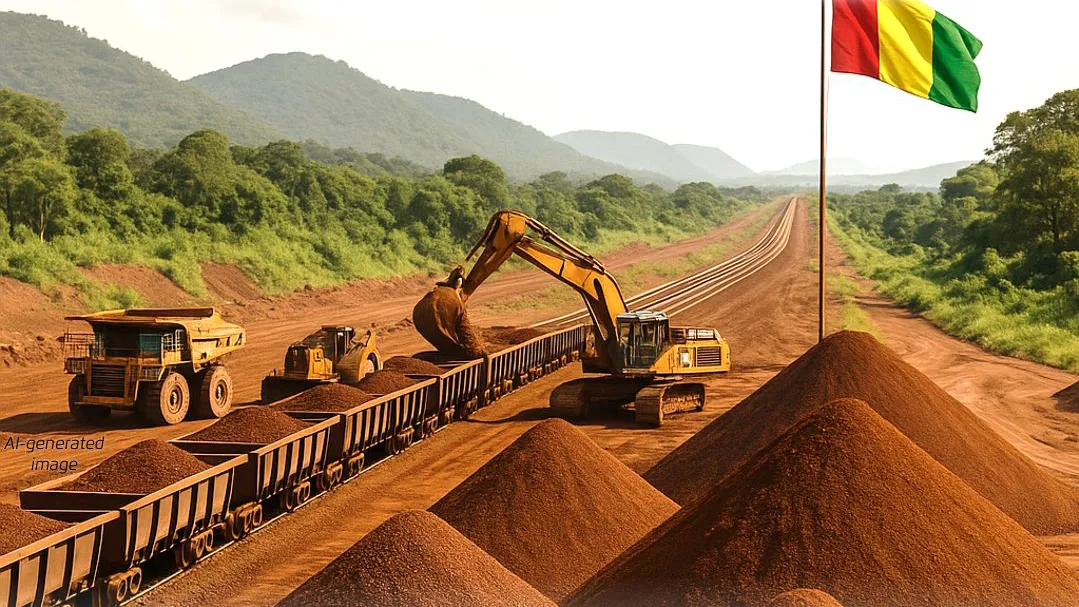Massive Milestone at Simandou: 2 Million Tonnes Stockpiled by Rio Tinto for First Shipment

Rio Tinto stockpiles 2M tonnes at Guinea’s Simandou, paving the way for first iron ore exports in Nov 2025 and Africa’s rise in global steel supply.
Rio Tinto has reached a defining milestone at its Simandou iron ore project in Guinea, stockpiling an impressive two million metric tons of high-grade ore in preparation for the project’s first commercial shipment, expected in mid-November 2025. This achievement marks a turning point not only for the Simandou venture but also for Africa’s broader mining landscape, as it positions the continent to play a much greater role in the global iron ore supply chain. The Simandou project, long considered one of the world’s most significant untapped iron ore deposits, is now moving from development into the operational phase, setting the stage for Guinea’s transformation into a key iron-ore exporter.
Rio Tinto’s subsidiary, Rio Tinto Simfer, which operates blocks 3 and 4 of the Simandou deposit, was responsible for accumulating around 1.5 million tonnes of ore during the third quarter of 2025. Ore loading onto railway wagons began in October, marking the first tangible step toward full-scale logistical operations. The export corridor—developed in partnership with the Winning Consortium Simandou (WCS), integrates a newly built deep-water port and an approximately 600-kilometre railway line connecting the mine to Guinea’s Atlantic coast. This modern infrastructure, jointly used by both Rio Tinto and its Chinese partners, will form one of West Africa’s most sophisticated mineral export systems.
Simandou’s ore is particularly prized for its exceptional quality, averaging around 65 percent iron content. This makes it one of the highest-grade iron ores globally and a valuable feedstock for low-emission steel production, which is becoming increasingly important in the transition to greener industrial practices. Once the project reaches full production capacity, expected around 2028,the entire Simandou complex is forecast to yield roughly 120 million tonnes of iron ore annually. Such an output could increase global seaborne supply by approximately 8 to 9 percent, potentially reshaping market dynamics dominated by producers in Australia and Brazil.
Economically, Simandou’s ramp-up represents a transformative opportunity for Guinea. According to projections, the project could boost the country’s gross domestic product (GDP) by up to 26 percent by 2030, making mining the backbone of national economic growth. The project’s long-term benefits include infrastructure expansion, employment creation, technology transfer, and enhanced regional connectivity through rail and port investments.
In a broader context, Rio Tinto’s progress at Simandou highlights Africa’s growing influence in global commodities markets. The continent’s ability to host world-class mining operations backed by multinational and Chinese investment underscores a shift toward greater participation in value-driven resource development. As Simandou transitions to commercial exports, it not only diversifies the global iron ore supply base but also strengthens Africa’s strategic role in supplying sustainable raw materials for the future of global industry.
Mini-Glossary
- Iron Ore (Fe): A mineral used primarily in steelmaking; high-grade ores contain over 60% iron and require less energy to process.
- Seaborne Supply: The portion of global mineral trade transported by sea, a key factor in international commodity pricing.
- GDP (Gross Domestic Product): A measure of a country’s total economic output, used to gauge national economic growth.
- Winning Consortium Simandou (WCS): A joint venture between Chinese and Singaporean entities developing part of the Simandou infrastructure, including rail and port facilities.
- Ramp-Up: The gradual increase in production levels as a mining project moves from initial operations to full-scale output.
- Deep-Water Port: A port capable of accommodating large cargo vessels, essential for bulk commodity exports such as iron ore.
